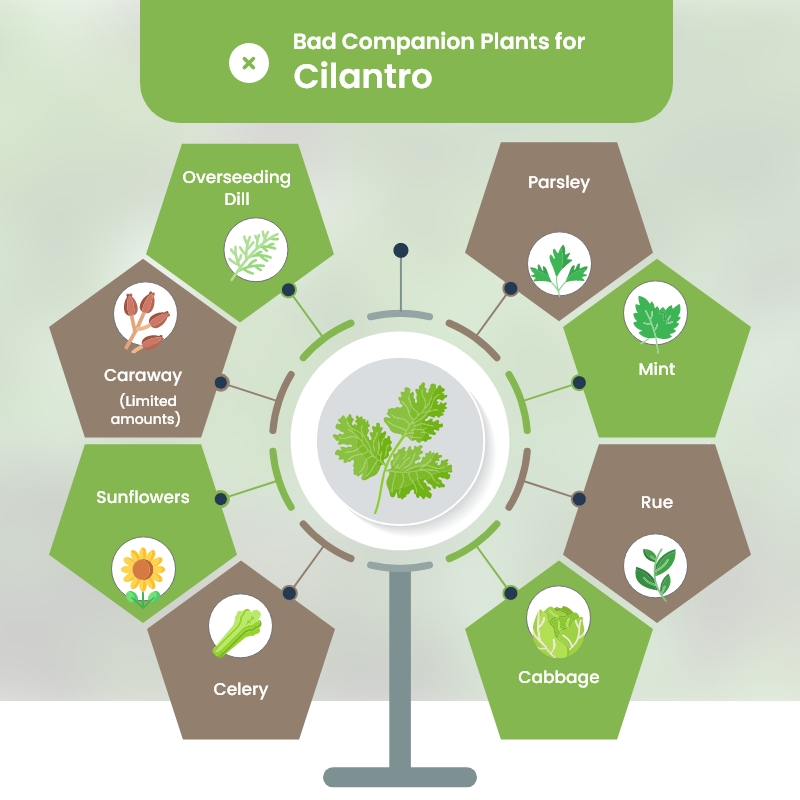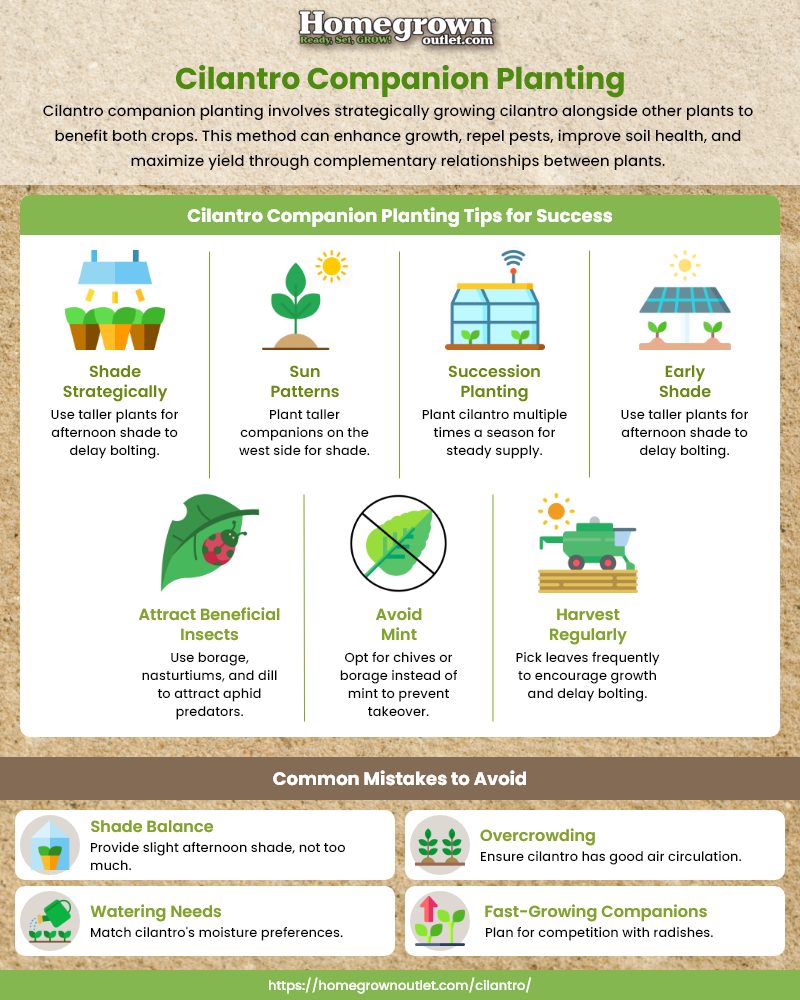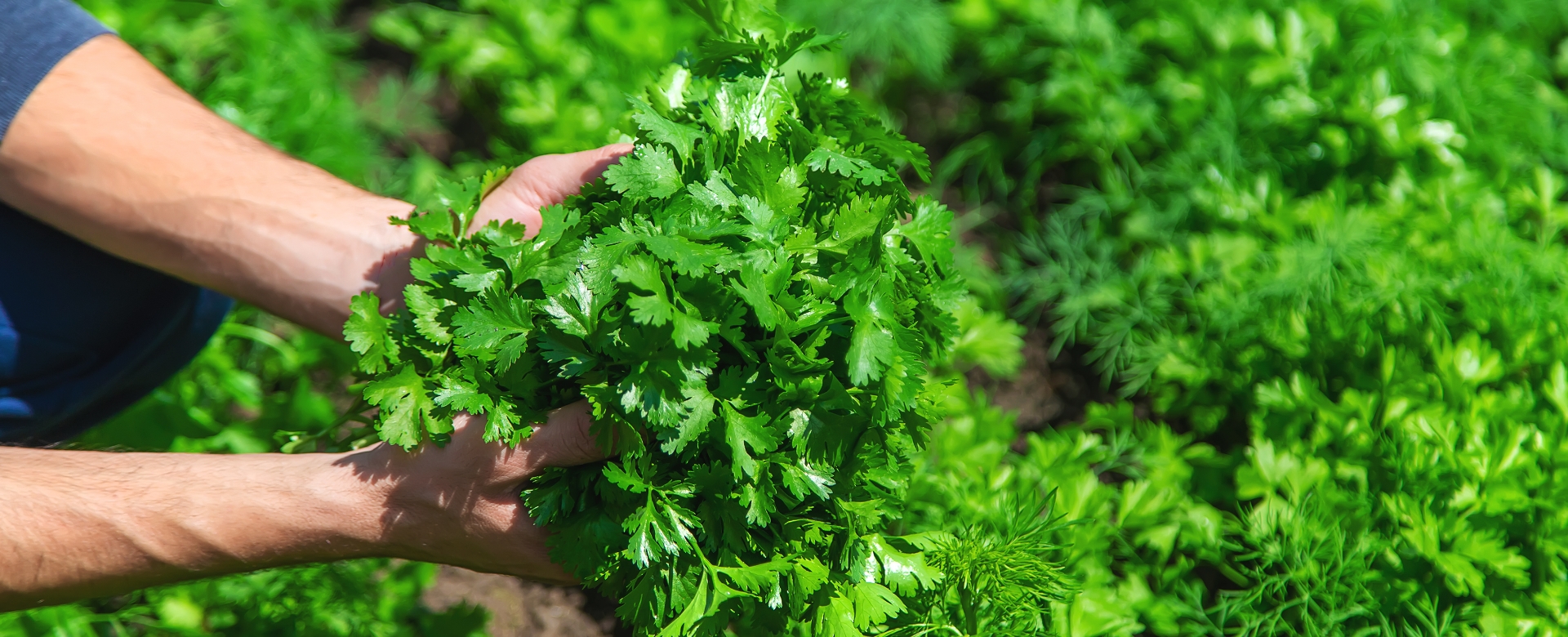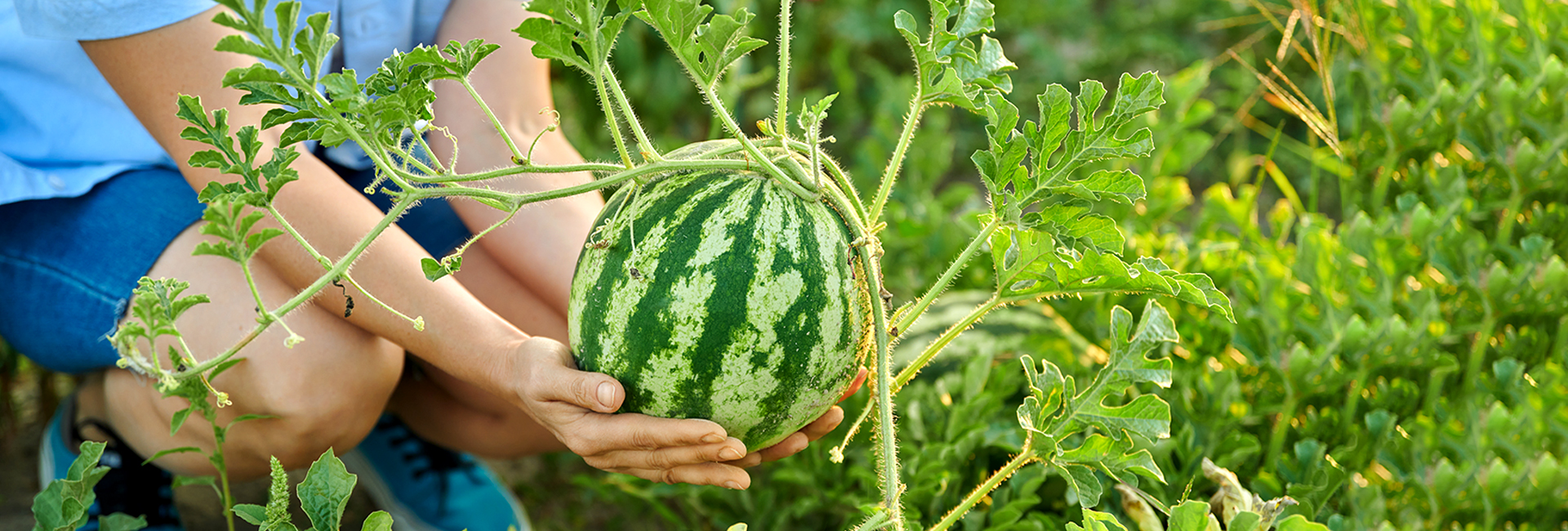Cilantro, that wonderfully fragrant herb, can be a fickle friend in the garden. Bolting (rapid flowering) and struggling in hot weather are common woes.
One issue that I commonly have is that my cilantro plants look great one day, but then a heat wave strikes, and they bolt the next.
But fear not, fellow herb enthusiast!
Companion planting offers a natural solution to cultivate thriving cilantro and enhance its flavor. The right cilantro companion plants, for example, can provide some much-needed afternoon shade to prevent bolting, or reduce pest pressure.
Are you looking for the best cilantro companion plants? Read our guide for best and worst pairs, tips for cilantro companion planting, and ideas for what to avoid.
What Are Cilantro Companion Plants?
Companion planting brings together beneficial plants for a mutually supportive garden ecosystem. The best companion plants are like good roommates.
A good companion for cilantro, for example, provides benefits like shade in hot weather (tall plants) or free fertilizer (nitrogen-fixing legumes) – like having someone who helps with chores or cooks sometimes.
Why companion plants? Some companions attract helpful insects that eat common cilantro foes (like aphids). And in some cases, the right companions can even aid in cilantro seed germination.
Simply stated, cilantro companion plants create a garden environment that will ensure you have a steady supply of this leafy herb all summer long.
Benefits of Companion Planting for Cilantro
Why should you companion plant with cilantro? You could just throw cilantro seeds in the garden anywhere, right?
Sure, you could. But companion planting is all about optimizing your garden space; placing the right plants near each other to deter pests and create beneficial microclimates for your favorite plants. Here are some benefits of cilantro companion planting:
- Slower bolting: Strategic companions can create a slightly cooler microclimate and deliver some much-needed shade to cilantro. This can help delay bolting and extending your cilantro harvest.
- Enhanced flavor: Some companions, like certain flowers, are believed to improve the overall taste and aroma of cilantro. (Does it actually work? You’ll have to try for yourself!)
- Friend with benefits: Cilantro, itself, is commonly used as a companion plant. That’s because its pungent smell can deter pests (and its blooms attract pollinators, if your cilantro does go to seed). In other words, whatever you plant near it will also benefit!
Best Companion Plants for Cilantro

What plants should you grow near cilantro? Generally, cilantro companion planting can help you deter pests to other plants, while creating the conditions cilantro needs to thrive.
Here are some good companion plants for cilantro:
1. Lettuce or Spinach
Depending on the variety you choose, lettuce and spinach can provide some shade for cilantro in hot weather. Some maturing Romaine heads, for example, work well for this.
So how do you get the shading right? First, watch the sun patterns in your garden. Next, you’ll want to plant lettuce on the west side of cilantro. Then, when the afternoon sun is beaming from the west, your lettuce provides a touch of respite.
Not only is this beneficial for cilantro. Lettuce and spinach also benefit from cilantro’s pest-repelling properties.
2. Radishes
Root crops, like radishes (or carrots), help to loosen the soil. And cilantro loves loose well-draining soil. However, radish greens tend to not get too tall, and the crop is grown in late spring or autumn.
Therefore, you are not going to get a ton of shade from these in summer. However, as an early-season pair, radishes can shade small cilantro seedlings.
3. Tomatoes
Another benefit of companion planting: You get great ingredients that go together well in cooking. Cilantro and tomatoes fit that bill perfectly. Generally, tomatoes benefit more than cilantro, as cilantro’s smell can mask the fragrance of tomatoes and deter whiteflies.
But you can also use strategically placed tomato plants to provide cilantro with afternoon shade. So, it’s a win-win!
4. Marigolds
Marigolds are the perfect companion plant for almost any vegetable or fruit (like tomatoes or peppers). That’s because marigolds deter harmful nematodes in the soil.
Plus, marigolds add a splash of vibrant yellow, orange or red to the garden, which can make your garden more visually appealing. Nasturtiums are another flower to consider, which can attract aphids away from cilantro.
5. Onions
Aphids are one of the most common cilantro pests. And onions are one of the best aphid repellants. They may also break up the soil a bit, which can help keep your cilantro patch thriving.
6. Beans
You can’t go wrong with beans in the garden. They’re easy-to-grow and prolific. Plus, they’re nitrogen-fixers. That means they encourage nitrogen to fix in the soil, which is a necessary nutrient for many herbs and vegetables (including cilantro).
Stick to bush beans, as pole and runner beans may cast too much of a shadow. Dragon’s Tongue beans make a good pair.
7. Dill (Limited amounts)
Both dill and cilantro enjoy similar growing conditions and attract beneficial hoverflies. However, avoid over seeding dill as it can crowd out cilantro.
They also work great with other herbs like chives. So, these herb companion pairs can generate a really beautiful herb garden.
Bad Companion Plants for Cilantro

OK, so what are bad roommates for cilantro? Well, some plants have different watering needs, or they may grow too quickly and crowd out cilantro plants.
Here are some top companion plants to avoid for cilantro:
- Parsley: While some herbs make good companions, parsley and cilantro may compete for nutrients.
- Mint: Mint’s aggressive growth habit can easily overtake and smother cilantro.
- Rue: This strong-scented herb can be overpowering for delicate cilantro. It also thrives in poor soil, something that cilantro hates.
- Brassicas (Broccoli, cabbage, etc.): These plants may have different watering needs than cilantro, making them a less-than-ideal pairing. For example, cilantro is sensitive to overwatering but gets stressed by drought, whereas brassicas can handle dry periods better.
- Celery: Like brassicas, celery has different watering requirements than cilantro, potentially leading to problems.
- Sunflowers: While beautiful, sunflowers can cast too much shade for sun-loving cilantro.
- Caraway: Caraway can release chemicals that inhibit cilantro growth.
- Over seeding Dill (mentioned earlier): As mentioned, avoid over seeding dill as it can crowd out cilantro.
Cilantro Companion Planting Tips for Success
You’ve picked the perfect cilantro pairings. Now what? Follow these tips for maximizing your success:
1. Shade Strategically
Cilantro enjoys some afternoon shade, especially in hot climates.
Use taller companions like lettuce, spinach, or tomatoes to provide dappled shade during the hottest part of the day. This keeps your cilantro cool, delaying bolting (flowering) and extending your harvest.
Generally, you’ll want to examine sun patterns in your garden. However, as rule of thumb, you’ll plant the taller pair on the western side. This will cast more shade during the hottest days of the afternoon.
2. Succession Planting is Key
Cilantro is a rapidly growing herb that can be planted multiple times throughout the season. In fact, bolting happens naturally, so a consistent crop usually requires multiple plants for a steady supply.
Take advantage of this by using fast-growing companions like radishes for early shade in spring. Sow cilantro seeds alongside them, and then plant additional cilantro seeds in a separate location later in the season for a continuous harvest.
3. Attract Beneficial Insects
Companion plants like borage, nasturtiums, and dill attract hoverflies, natural predators of aphids, a common cilantro pest. These beneficial insects will help keep your cilantro healthy without relying on harsh chemicals.
4. Mind Your Mint
While many herbs make good companions, mint is a fast-growing spreader that can easily overwhelm delicate cilantro. Opt for alternative companions like chives or borage that offer the same benefits without the risk of takeover.
5. Harvest Regularly
Don’t wait until your cilantro plants are overgrown to harvest. Regularly picking leaves encourages new growth and helps delay bolting.

Common Mistakes to Avoid
Afternoon shade is beneficial for cilantro. But make no mistake, cilantro does love the sun. Casting too much shade throughout the day can lead to leggy, weak cilantro plants.
This tends to be the biggest mistake gardeners make – over shading their cilantro plants. All you really need is some slight shade during those hot afternoons in July and August for ideal conditions.
Some other mistakes include:
- Overcrowding: Cilantro thrives with good air circulation. Planting companions too close can smother your cilantro plants and hinder their growth. Research the mature size of both cilantro and its companions and ensure proper spacing for each.
- Ignoring Watering Needs: Cilantro does best with consistent moisture but dislikes soggy soil. Choose companion plants with similar watering requirements to avoid overwatering or underwatering your cilantro. For this reason, most brassicas, asparagus, and celery aren’t great pairs.
- Forgetting Fast-Growing Companions: Some companion plants, like radishes, grow quickly and can outcompete cilantro for space and resources later in the season. If using fast-growing companions for early shade, plan to sow additional cilantro seeds later in a separate location.
Conclusion
Companion planting with cilantro is a wonderful way to cultivate a thriving cilantro patch. By creating a supportive plant community, you can enjoy a longer harvest, more flavorful cilantro, and a vibrant garden ecosystem!
But here’s a key to remember: Companion planting is not a magic bullet. Regular watering, weeding, and providing essential nutrients are still crucial for healthy cilantro plants. Need some help? See our organic gardening tips for more ideas!
FAQs
Both methods can work! If using fast-growing companion plants like radishes for early shade, you can sow cilantro seeds directly alongside them.
For slower-growing companions like tomatoes, you may prefer to sow cilantro seeds separately to ensure proper germination and spacing.
Companion planting can definitely help! For companion plants for cilantro, strategic pairs like lettuce or tomatoes provide shade, keeping cilantro cooler and delaying the flowering process. This extends your harvest window and allows you to enjoy fresh cilantro leaves for a longer period.
Absolutely! Don't discard those cilantro flowers. They are edible and have a milder, slightly citrusy flavor compared to the leaves (you might know them as “coriander” in your spice cabinet). You can use them in salads, soups, or even infuse them into vinegar.
There's some debate surrounding this. Dill and cilantro share similar growing conditions and attract hoverflies, beneficial insects that help control pests. However, overseeding dill can crowd out cilantro. The key is to plant them strategically with enough space for both to thrive.
Borage flowers are excellent companions for cilantro, attracting bees and beneficial insects. While borage can self-seed readily, it's not overly aggressive. Regularly deadheading (removing spent flowers) will prevent excessive self-seeding and keep your borage plant under control.




